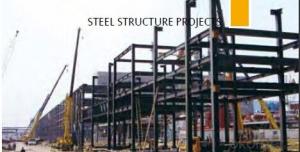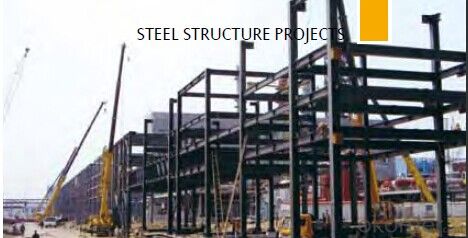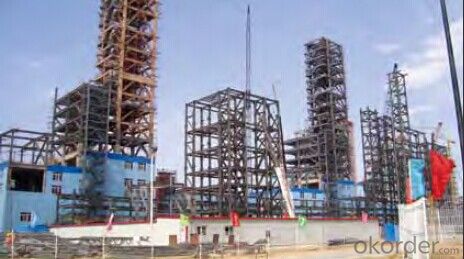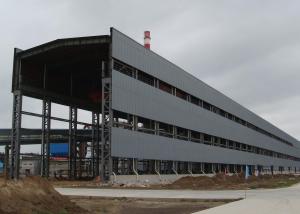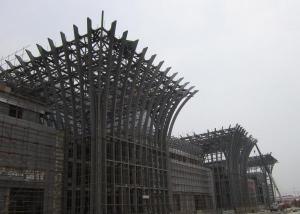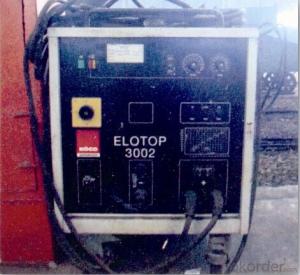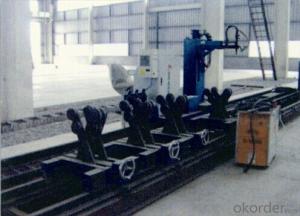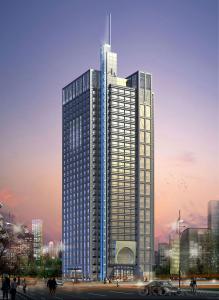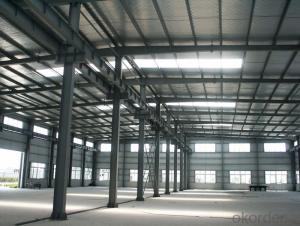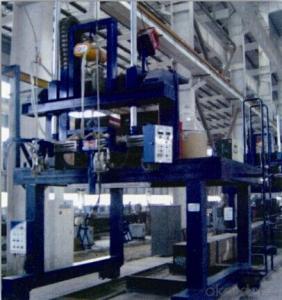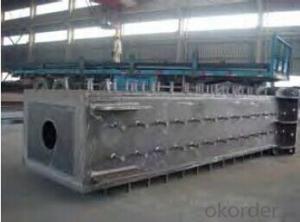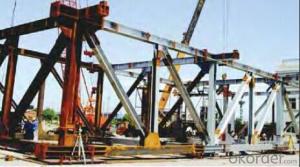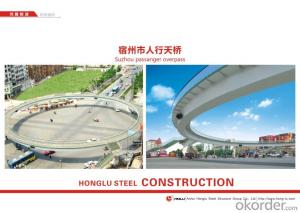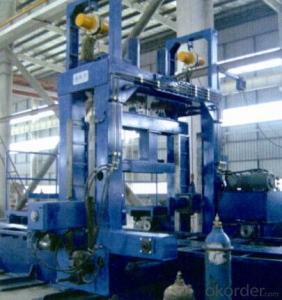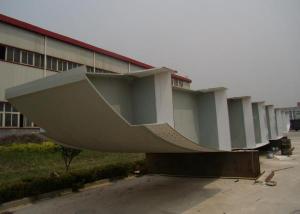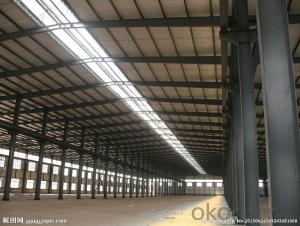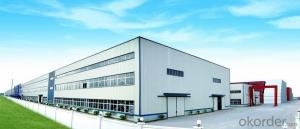High Quality-work made in China
- Loading Port:
- China Main Port
- Payment Terms:
- TT OR LC
- Min Order Qty:
- -
- Supply Capability:
- -
OKorder Service Pledge
OKorder Financial Service
You Might Also Like
Steel Structure
Description:
1.Length of the welding withnot indication, full welding should be applied
2.Seam without indication is fillet weld, height is 0.75t
3.The cutting angle without indication, radius R=30
4.Cutting angle not specified should be
5.The diameter of the hole for the bolt if not specified, D=22
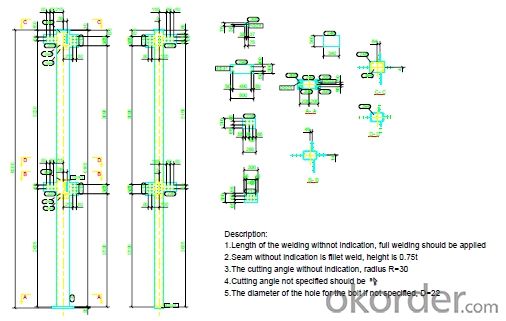
Project Reference:
Area: 17,000m2
Steel Structure Quantity: 2,700ton
Color-Steel Plate Area: 29,670ton
Column Height: 32m
Weight of Per Column: 25ton
Crane Tonnage: 300ton
Total Cost: 25,080,000RMB
Duration: 150days
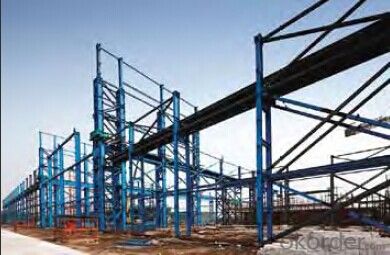
- Q: What is the role of steel in historical and heritage buildings?
- The significance and complexity of steel in historical and heritage buildings cannot be overstated. Steel has been instrumental in the creation and conservation of these structures, offering strength, longevity, and adaptability. From a historical perspective, steel emerged as a prominent material during the late 19th and early 20th centuries as a result of the Industrial Revolution. Its introduction revolutionized the fields of architecture and engineering, enabling the construction of taller and more expansive buildings. By utilizing steel frames and beams, architects were able to provide enhanced structural support, resulting in the creation of magnificent edifices with larger open spaces and intricate designs. In the context of heritage buildings, steel has frequently been employed in restoration and rehabilitation endeavors. Over time, many historical structures suffer from structural decay, and steel is often employed to reinforce weakened or damaged sections. Its exceptional tensile strength and ability to withstand heavy loads make it an ideal material for fortifying weakened foundations, walls, or floors. Furthermore, steel is also utilized in the restoration of ornate architectural elements. Historical buildings often feature intricate ironwork, such as balconies, railings, or decorative facades. When these elements deteriorate or become damaged, steel can be employed to replicate or substitute them, ensuring the preservation of the building's original aesthetic. Moreover, steel plays a pivotal role in the adaptive reuse of historical and heritage buildings. Many aged structures are repurposed for new functions, such as transforming a factory into a museum or converting a warehouse into residential lofts. The versatility of steel empowers architects and engineers to modify the building's interior layout while preserving its historical exterior. Steel beams can be added or altered to accommodate new spaces or provide support for additional floors, facilitating the necessary flexibility for modern usage. Finally, steel represents a sustainable choice for historical and heritage buildings. Its recyclable nature and durability make it an environmentally friendly material. By employing steel in restoration or adaptive reuse projects, we can minimize the demand for new materials and reduce waste, thereby contributing to the preservation of these invaluable structures for future generations. In conclusion, steel assumes a critical role in historical and heritage buildings, both during their initial construction and ongoing preservation. Its strength, durability, versatility, and sustainability render it the material of choice for reinforcing structures, restoring ornate elements, adapting buildings for new purposes, and ensuring the longevity of these iconic landmarks.
- Q: What are the factors that affect the constructability and ease of assembly of a steel structure?
- The factors that affect the constructability and ease of assembly of a steel structure include the complexity of the design, availability of skilled labor, access to the construction site, weather conditions, transportation and logistics, availability of necessary equipment and tools, and the accuracy of the fabrication and detailing of steel components. Additionally, factors such as the size and weight of steel members, the need for temporary supports or bracing, and the compatibility of different steel components also play a role in determining the constructability and ease of assembly of a steel structure.
- Q: How are steel structures fabricated and assembled?
- Steel structures are fabricated through a process called steel fabrication, which involves cutting, bending, and shaping steel components according to the design specifications. These components are then assembled using welding or bolting techniques to form the desired structure.
- Q: What are the different types of steel corrosion protection systems used in structures?
- Structures commonly use various types of steel corrosion protection systems to prevent or minimize steel corrosion. Steel corrosion can lead to structural deterioration and failure over time. One commonly used corrosion protection system is protective coatings. These coatings act as a barrier between the steel and the environment, preventing moisture and other corrosive agents from contacting the metal. Protective coatings, such as epoxy, polyurethane, and zinc-rich coatings, offer excellent corrosion resistance and can be applied through painting, spraying, or dipping processes. Another corrosion protection system is cathodic protection. This method involves connecting the steel to a sacrificial anode, a more reactive metal that will corrode instead of the steel. This creates a galvanic cell, where the anode corrodes instead of the steel. Cathodic protection is useful in moist environments or structures immersed in water, like pipelines, storage tanks, and offshore structures. Galvanizing and metal spraying are also corrosion protection systems. Galvanizing coats the steel with a layer of zinc through a hot-dip process, acting as a sacrificial anode. Metal spraying involves applying a layer of molten metal onto the steel surface, creating a protective barrier against corrosion. Proper design and maintenance practices can further contribute to corrosion protection. These practices may include ensuring adequate drainage to prevent moisture accumulation, regularly inspecting and cleaning steel surfaces, and using corrosion inhibitors in specific environments. The selection of a corrosion protection system depends on factors like environmental conditions, expected structure lifespan, and desired corrosion resistance level. Implementing the appropriate corrosion protection system can significantly improve the longevity and structural integrity of steel structures.
- Q: How are steel structures inspected for quality and safety?
- Steel structures are inspected for quality and safety through a combination of visual inspections, non-destructive testing techniques, and adherence to industry standards and codes. Trained inspectors thoroughly examine the structural components, welds, connections, and coatings to ensure they meet the required specifications. Various non-destructive testing methods, such as ultrasonic testing and magnetic particle testing, are employed to detect any hidden defects or flaws that could compromise the integrity of the structure. Additionally, regular inspections are conducted throughout the construction process and during the service life of the structure to ensure ongoing safety and maintenance compliance.
- Q: What are the requirements for designing steel sports facilities?
- The requirements for designing steel sports facilities include factors such as structural integrity, durability, flexibility, and safety. Steel structures should be able to withstand heavy loads and provide adequate support for the sports activities taking place. Additionally, they should be resistant to weather conditions and potential damage from impacts. Proper ventilation, lighting, and accessibility for athletes and spectators are also important considerations. Compliance with building codes and regulations, as well as adherence to specific sport governing body guidelines, is crucial in the design process.
- Q: What are the different types of steel frame systems used in structures?
- There are several types of steel frame systems used in structures, including moment-resisting frames, braced frames, and composite frames.
- Q: How are steel structures used in the construction of supermarkets?
- Steel structures are commonly used in the construction of supermarkets due to their numerous advantages. Firstly, steel is a strong and durable material, making it ideal for supporting the large spans and heavy loads that supermarkets require. It can withstand high winds, earthquakes, and other natural forces, ensuring the safety of the building and its occupants. Moreover, steel structures offer flexibility in design and construction. Supermarkets often need large open spaces to accommodate a variety of products, shelving, and aisles. Steel beams and columns can be easily customized and fabricated to create these open floor plans, allowing for maximum utilization of space. Additionally, steel structures offer speed and efficiency in construction. Prefabricated steel components can be manufactured off-site and then quickly assembled on-site, reducing construction time and costs. This is particularly advantageous for supermarkets, as they often have tight project schedules and need to open their doors to customers as soon as possible. Another benefit of steel structures is their versatility. They can be easily modified or expanded in the future, allowing supermarkets to adapt to changing needs or market trends. This flexibility is crucial in the retail industry, where store layouts and product displays may need to be altered to meet evolving customer preferences. Lastly, steel structures are environmentally friendly. Steel is a recyclable material, and many steel components used in construction are made from recycled steel. This helps reduce the demand for new raw materials and minimizes waste. Additionally, steel structures can be designed to be energy-efficient, incorporating insulation and efficient HVAC systems to reduce energy consumption and operating costs. In conclusion, steel structures are widely used in the construction of supermarkets due to their strength, flexibility, speed of construction, versatility, and environmental sustainability. They provide the necessary support and space for supermarkets to operate efficiently and effectively, ensuring a safe and comfortable shopping experience for customers.
- Q: How do steel structures perform in terms of durability and lifespan?
- Steel structures are highly durable and have a long lifespan. Due to their high strength, steel structures can withstand harsh environmental conditions, including extreme temperatures, heavy loads, and natural disasters. Additionally, steel is resistant to corrosion, which further enhances its longevity. With proper maintenance and care, steel structures can last for decades, making them a reliable choice for various construction projects.
- Q: How are steel structures used in water treatment plants?
- Due to their strength, durability, and versatility, steel structures are widely utilized in water treatment plants. Their crucial role lies in supporting various components and equipment necessary for water treatment processes. One of the primary functions of steel structures in water treatment plants is to house and support large storage tanks. These tanks, made of steel, are commonly employed for storing raw water, treated water, chemicals, and sludge. The steel structure ensures the tanks' safety by providing the required stability and strength, preventing any leakage or damage. Furthermore, steel structures support and house various water treatment equipment, including pumps, filters, clarifiers, and disinfection systems. These structures are specifically designed to endure the weight and forces generated by the equipment, guaranteeing their proper functioning. Moreover, steel structures are utilized to create walkways, platforms, and catwalks within water treatment plants. These structures serve two purposes: facilitating maintenance and inspection of equipment and ensuring worker safety by preventing contact with hazardous areas or substances. Additionally, steel structures are involved in constructing water intake and outfall structures. These structures are engineered to withstand the forces exerted by water flow and provide a stable foundation for pumps and screens used in the intake and discharge processes. In conclusion, steel structures are indispensable in water treatment plants as they offer the necessary support, stability, and durability essential for the efficient and safe operation of various components and equipment involved in water treatment processes.
Send your message to us
High Quality-work made in China
- Loading Port:
- China Main Port
- Payment Terms:
- TT OR LC
- Min Order Qty:
- -
- Supply Capability:
- -
OKorder Service Pledge
OKorder Financial Service
Similar products
Hot products
Hot Searches
Related keywords
